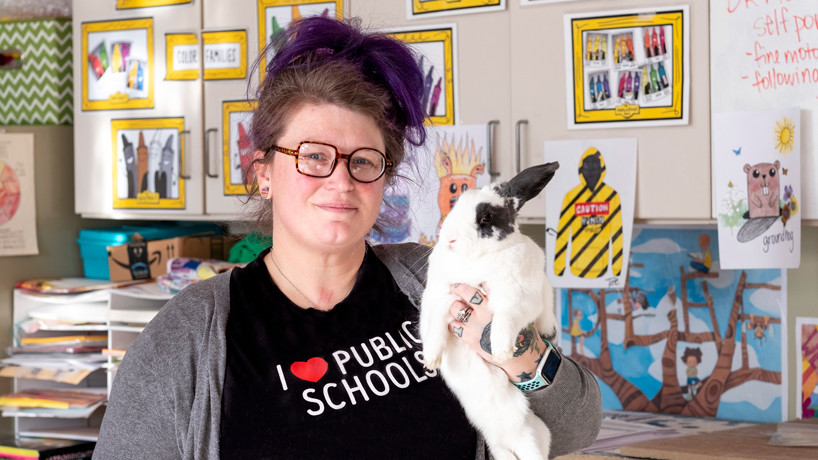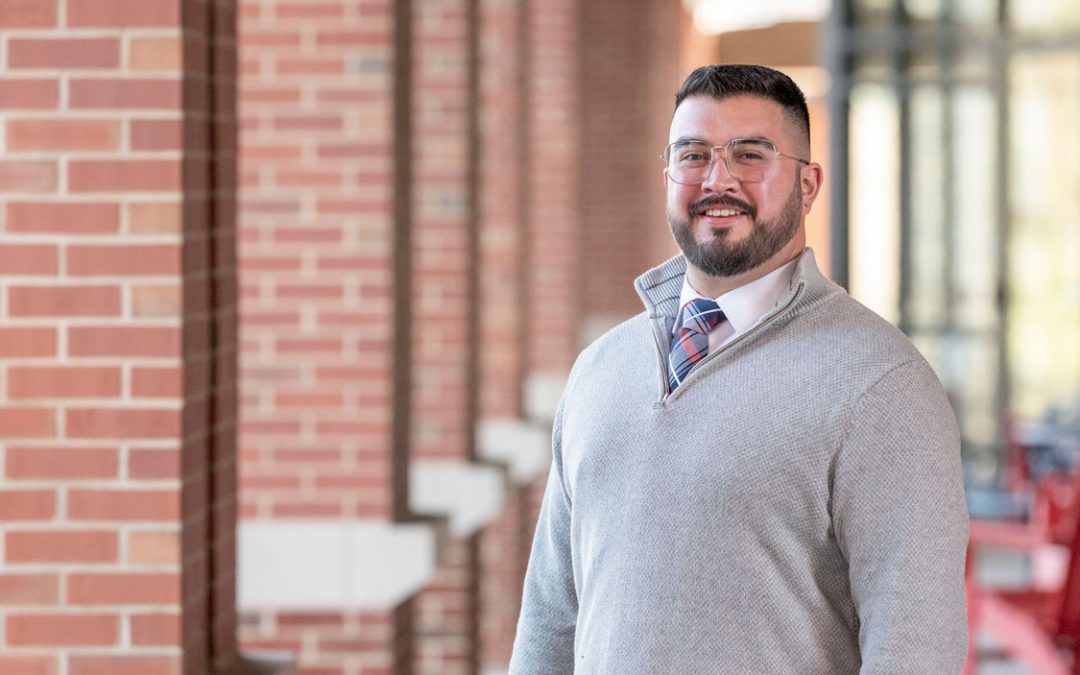
Britt Tate (with her rabbit Bunilla Ice) is part of the College of Education’s Heritage Leadership for Sustainability, Social Justice and Participatory Culture EdD cohort and splits her time between Bryan Hill Elementary School and Columbia Elementary School teaching art. As a product of public schools, she believes that every student deserves a passionate, enthusiastic teacher – no matter what neighborhood they live in. (Photo by August Jennewein)
Britt Tate wanted to move to Chicago. Her husband wanted to move to Houston.
So they met each other in the middle – literally. The couple decided to move somewhere between the two cities.
“St. Louis had all of these things that we were really looking for,” Tate said of their final decision. “It had a fairly diverse population. It had all the qualities of a major city, but it was affordable. And it had colleges.”
The move began as a compromise, but it has begun to look more and more like an incredibly prescient decision.
Since moving to St. Louis, Tate has been named a St. Louis Public Schools 2019 Educator of the Year, featured on Humans of St. Louis and started her EdD at the University of Missouri–St. Louis College of Education.
Tate, who splits time as an art teacher at Bryan Hill Elementary School and Columbia Elementary School on the north side of St. Louis, always had a suspicion she would end up in the classroom. However, it didn’t happen how she imagined.
“It was probably destiny from the very beginning,” she said. “I think I always sort of knew I’d end up in the classroom. I thought I’d end up a college professor or a high school art teacher, but having worked in elementary art for a few years, these are my people. This is my bubble – the little kids.”
Growing up in Illinois, Tate was inspired by her public school art teachers to pursue the discipline. She earned a BFA from Columbia College Chicago and then entered a master’s program at the Cranbrook Academy of Art in Detroit.
Her future-brother-in-law, whom she rarely saw eye-to-eye with, was also going to school in Detroit, and he joked that Tate should meet his brother because they were both irritating in the same way.
“I was like, ‘Oh, he sounds great,’” Tate said with a laugh. “He was like, ‘Yeah, you should marry him.’ Fast forward three years, and I married him.”
The couple moved to Philadelphia, where her husband’s family is from. Tate did a few odd jobs to make ends meet but eventually wound up working in bakeries as a pastry chef. Her master’s work had focused on American consumption, and she had learned to bake and decorate elaborate desserts to use in her art.
She loved the bakery but missed the Midwest, which precipitated the fateful move.
Tate continued to work as a pastry chef in St. Louis, first at Jilly’s Cupcake Bar & Café, then at Sarah’s Cake Shop. However, after having three kids, including twins, it became obvious that the hours of a professional baker were not compatible with young children.
It led to a solo operation, with Tate producing wedding cakes and dessert bars from her home while taking care of the kids. Soon they were old enough for school, and Tate began looking for jobs that would work with their schedule. Leveraging her art degrees to teach was a natural next step.
UMSL’s Teach Residency program allowed her to work toward full certification while teaching. Candidates agree to teach in an urban public school or public charter school for two years and must also have a bachelor’s degree. In return, the university provides the necessary coursework to earn teacher certification within two years.
Teaching for an urban public school was part of the deal, but it was something Tate would have done anyway. As a product of public schools, she believes that every student deserves a passionate, enthusiastic teacher – no matter what neighborhood they live in.
“After we had lived here for a while, you sort of pick up on the, ‘Where did you go to high school?’ thing,” she said. “You learn a lot about the school system, so I knew I wanted to be in the city.”
Tate’s first position was at Carver Elementary School. After a few years, she transferred, splitting time between Bryan Hill and Columbia. The “Delmar Divide” was evident immediately as a parent of students attending south side schools.
The racial and socioeconomic disparities bisecting the city have presented challenges, but the experience has been incredibly positive nonetheless.
“I love what I’ve been able to do on the north side,” Tate said. “I love the principals I’ve worked for, who have been very open to letting me create and curate my curriculum.
“They don’t always understand what I’m up to when they walk into the room, but kids are always engaged and always excited. We’re always learning and trying out new things. I’ve really had the luxury of curating my own curriculum and designing it around artists that I think are important to my students, not necessarily artists that I think are important to me.”
Her students, who are mostly Black, learn about contemporary Black artists such as Derek Fordjour, Kehinde Wiley and Ebony Patterson, who not only look like them but also tackle issues that students deal with on a daily basis. This determination to reach her students and provide culturally relevant education contributed to her 2019 Educator of the Year Award.
That year, Tate also enrolled in an EdD program at UMSL, the Heritage Leadership for Sustainability, Social Justice and Participatory Culture cohort, led by Theresa Coble, the E. Desmond Lee Endowed Professor of Experiential and Family Education.
Coble recommended the program to Tate after they worked together on a project for Forest Park Forever. It encompassed many of the things Tate was already trying to bring to her classroom, and she was particularly motivated after a tragic event.
“I had just lost a student to gun violence that summer,” Tate said. “So I was very, very hellbent on social justice issues, especially as they relate to education and equity, having been to a 10-year-old’s funeral a month and a half before.”
In 2020, her social justice studies at UMSL coincided with several significant events such as the onset of the COVID-19 pandemic, which has had a disproportionate effect on Black communities in St. Louis and underscored the digital divide in the city, and a wave of protests after the deaths of George Floyd and Breonna Taylor.
Tate has taken the opportunity to showcase the street art and digital art that came out of the protests and to rethink what art class looks like when half her students are learning remotely.
Her students have done Q&A sessions with artists via Zoom, gone on virtual gallery tours and designed Black Panther themed sneakers in honor of Chadwick Boseman, the late actor who portrayed the Marvel superhero. The students have also been doing a lot illustrating since the materials are easily accessible to everyone.
“Right now, we have an opportunity to completely throw out the old playbook and try some really cool, new things,” Tate said. “Really experiment with this idea of makerspaces and letting kids do a lot of self-discovery and put a lot of the onus on kids to curate their education.”
Tate is working toward finishing her EdD and expects to eventually use it outside of the classroom. For now, though, she’ll fight to encourage every student through art.
“So much confidence comes out of feeling like a good artist,” she said. “If you feel like you can create and you feel like you have the confidence to experiment, I think that that’s really, really important. I think it helps pave the way for some creative license and experimentation later in academics.”














